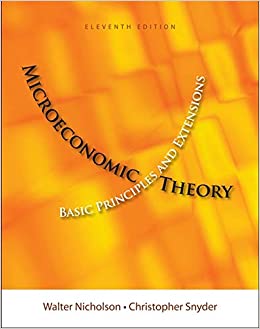
Microeconomic Theory 11th Edition by Walter Nicholson,Christopher Snyder
Edition 11ISBN: 978-1111525538
Microeconomic Theory 11th Edition by Walter Nicholson,Christopher Snyder
Edition 11ISBN: 978-1111525538 Exercise 2
Suppose a firm's total revenues depend on the amount produced (q) according to the function
R = 70q - q 2.
Total costs also depend on q:
C = q 2 + 30q + 100.
a. What level of output should the firm produce to maximize profits (R - C)? What will profits be?
b. Show that the second-order conditions for a maximum are satisfied at the output level found in part (a).
c. Does the solution calculated here obey the ''marginal revenue equals marginal cost'' rule? Explain.
R = 70q - q 2.
Total costs also depend on q:
C = q 2 + 30q + 100.
a. What level of output should the firm produce to maximize profits (R - C)? What will profits be?
b. Show that the second-order conditions for a maximum are satisfied at the output level found in part (a).
c. Does the solution calculated here obey the ''marginal revenue equals marginal cost'' rule? Explain.
Explanation
Total revenue is the amount earned by the firm by its operations.
Total cost is the production cost incurred by the firm to produce the commodity.
Profit is the difference between the total revenue and total cost.
a)
Profit maximizing firm produces the output at that level where difference between total revenue and total cost is maximum.
 Necessary condition is as follows:
Necessary condition is as follows:
 Sufficient condition is as follows:
Sufficient condition is as follows:
 Calculate the profit as follows:
Calculate the profit as follows:
 Thus, firm produces
Thus, firm produces
 of output and earns
of output and earns
 profits.
profits.
b)
Second-order condition of profit maximization is
 . It is also called sufficient condition.
. It is also called sufficient condition.
 Thus, second order condition is satisfied at 10 unit of output.
Thus, second order condition is satisfied at 10 unit of output.
c.
Profit maximizes where marginal revenue is equal to marginal cost. Marginal revenue is additional revenue in total revenue while selling one more unit of product. Marginal cost is additional cost in total cost while producing one more unit of product.
Calculate as follows:

 Yes, the solution obeys the rule 'marginal revenue equals to marginal cost'.
Yes, the solution obeys the rule 'marginal revenue equals to marginal cost'.
Total cost is the production cost incurred by the firm to produce the commodity.
Profit is the difference between the total revenue and total cost.
a)
Profit maximizing firm produces the output at that level where difference between total revenue and total cost is maximum.
 Necessary condition is as follows:
Necessary condition is as follows: Sufficient condition is as follows:
Sufficient condition is as follows: Calculate the profit as follows:
Calculate the profit as follows: Thus, firm produces
Thus, firm produces of output and earns
of output and earns  profits.
profits. b)
Second-order condition of profit maximization is
 . It is also called sufficient condition.
. It is also called sufficient condition. Thus, second order condition is satisfied at 10 unit of output.
Thus, second order condition is satisfied at 10 unit of output. c.
Profit maximizes where marginal revenue is equal to marginal cost. Marginal revenue is additional revenue in total revenue while selling one more unit of product. Marginal cost is additional cost in total cost while producing one more unit of product.
Calculate as follows:

 Yes, the solution obeys the rule 'marginal revenue equals to marginal cost'.
Yes, the solution obeys the rule 'marginal revenue equals to marginal cost'.Microeconomic Theory 11th Edition by Walter Nicholson,Christopher Snyder
Why don’t you like this exercise?
Other Minimum 8 character and maximum 255 character
Character 255


